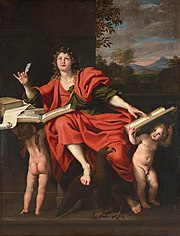
Back رسائل يوحنا Arabic رسايل يوحنا ARZ Johannes' Breve Danish Briefe des Johannes German Epístolas de Juan Spanish Joanen gutunak Basque Épîtres de Jean French Epístolas de Xoán Galician איגרת יוחנן HE Surat-surat Yohanes ID
| Part of a series of articles on |
| John in the Bible |
|---|
 |
| Johannine literature |
| Authorship |
| Related literature |
| See also |

The Johannine epistles, the Epistles of John, or the Letters of John are the First Epistle of John, the Second Epistle of John, and the Third Epistle of John, three of the catholic epistles in the New Testament. In content and style they resemble the Gospel of John. Specifically in the First Epistle of John, Jesus is identified with the divine Christ, and more than in any other New Testament text, God's love of humanity is emphasised.[1]
The letters are anonymous, but since the late second century, when Irenaeus referred to the first two epistles, they have been connected to John, son of Zebedee, who according to the gospels was one of the twelve disciples and part of Jesus's closest circle.[2] The third epistle is mentioned beginning in the middle of the third century, and due to its similarity with the Second Epistle of John (e.g. both being written by someone referred to as the elder) it was included with the other two, creating the collection known as the Johannine epistles.[2] Athaneus's festal letter of 367 is the earliest case of the three letters being counted as catholic.[2][3] While the second and third epistles appear to be real letters, the first epistle lacks both introduction and ending, more resembling an exhoratory writing or a sermon.
Most scholars assume the letters to have been written simultaneously and after the Gospel of John, dating them between AD 85 and 100.[4] Most scholars agree that all three letters are written by the same author, although there is debate on who that author is.[5][6][7] Most often, the letters are attributed to someone in the Johannine community, most often a letter redactor of the Gospel.[2] A popular theory is that they were written by a presbyter, called John the Presbyter, who is named by Papias.[8]
- ^ Olsson, Birger (2008). Johannesbreven. Stockholm: EFS-förlaget. ISBN 978-91-7085-104-9.
- ^ a b c d Coogan, Michael David (2011). The Oxford encyclopedia of the books of the Bible. New York: Oxford University Press. pp. 472–477. ISBN 978-0-19-537737-8.
- ^ Mack, Burton L. (1995). Who wrote the New Testament?: the making of the Christian myth. HarperSan Francisco. p. 207. ISBN 0-06-065517-8.
- ^ Tenney, Merrill. "THE EPISTLES OF JOHN". www.abideinchrist.com. Retrieved 27 September 2012.
- ^ Kruger, Michael J. (30 April 2012). Canon Revisited: Establishing the Origins and Authority of the New Testament Books. p. 272. ISBN 9781433530814.
- ^ Brown, Raymond E. (1988). The Gospel and Epistles of John: A Concise Commentary. p. 105. ISBN 9780814612835.
- ^ Marshall, I. Howard (14 July 1978). The Epistles of John. ISBN 9781467422321.
- ^ Powell, Mark Allan (2009). Introducing the New Testament: A Historical, Literary, and Theological Survey. Baker Academic. ISBN 9780801028687.